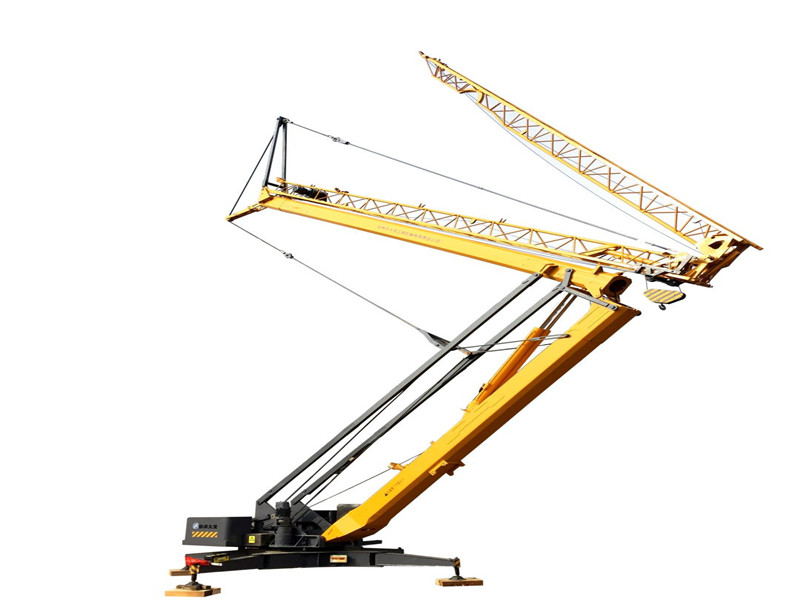A mobile tower crane is a cutting-edge lifting solution that combines the advantages of both tower cranes and mobile cranes. It offers the versatility of a mobile crane with the height and lifting capacity of a traditional tower crane. In this article, we will delve into the features, benefits, and applications of mobile tower cranes in the construction industry.

A mobile tower crane, also known as a self-erecting tower crane, is a specialized lifting equipment used in construction projects. Unlike traditional tower cranes that require assembly on-site, a mobile tower crane is self-contained and can be transported to the construction site as a single unit. It offers a unique combination of mobility, ease of setup, and lifting capacity, making it an efficient and cost-effective choice for various construction applications.
A mobile tower crane operates using a hydraulic jacking system that enables self-erection. The crane is transported to the site on a mobile chassis and unfolds hydraulically, extending its tower sections to the desired height. Once fully extended, the crane can perform lifting operations similar to a stationary tower crane.
Mobile tower cranes come with several key features that enhance their performance and usability:
The hydraulic self-erection feature allows the crane to be set up quickly and easily without the need for additional equipment or manual assembly. This saves valuable time and labor during project mobilization.
Mobile tower cranes have a compact footprint, making them suitable for projects with limited space or challenging site conditions. Their small size allows them to maneuver in tight areas and reach areas that are difficult to access for larger cranes.
Despite their compact size, mobile tower cranes offer impressive lifting capacities. They can lift heavy loads with precision and stability, making them ideal for a wide range of construction tasks.
Mobile tower cranes are designed for easy transportation between different job sites. They can be quickly disassembled and loaded onto trailers or trucks for transportation, eliminating the need for costly disassembly and reassembly processes.
The use of a mobile tower crane brings several advantages to construction projects:
Mobile tower cranes offer a versatile lifting solution, combining the mobility of a mobile crane with the height and lifting capacity of a tower crane. They can perform a wide range of lifting tasks, from small-scale residential projects to larger commercial or industrial developments.
The quick setup and dismantling process of mobile tower cranes save significant time and labor costs compared to traditional tower cranes. They require minimal assembly and disassembly, allowing for faster project completion and reduced downtime.
With their high lifting capacity and precise controls, mobile tower cranes improve overall project efficiency. They can handle heavy loads with accuracy and safety, minimizing the risk of accidents and delays.
Mobile tower cranes adhere to stringent safety standards and regulations. They are equipped with advanced safety features such as load moment indicators, anti-collision systems, and emergency stop controls, ensuring the safety of both the operators and the construction site.
Mobile tower cranes find applications in various construction projects, including:
They are commonly used in residential construction projects, such as the erection of apartment buildings, housing complexes, and single-family homes.
Mobile tower cranes play a vital role in infrastructure projects, including bridge construction, highway construction, and urban development.
Their compact size and maneuverability make mobile tower cranes suitable for renovation and restoration projects where space is limited or access is challenging.
They are utilized in industrial construction projects, such as the construction of factories, warehouses, and manufacturing facilities.
Safety should always be a top priority when operating a mobile tower crane. Operators should undergo proper training and follow safety protocols to prevent accidents. Regular inspections and maintenance should be conducted to ensure the crane's components are in optimal condition.
To maintain the performance and longevity of a mobile tower crane, regular maintenance is essential. This includes routine inspections, lubrication of moving parts, and prompt repairs of any malfunctioning components. Following the manufacturer's maintenance guidelines and recommendations is crucial.
Mobile tower cranes have revolutionized the construction industry by offering a versatile and efficient lifting solution. With their unique combination of mobility, high lifting capacity, and ease of setup, they streamline construction processes and contribute to project success. By utilizing mobile tower cranes, construction companies can improve productivity, save time and costs, and ensure the safety of their operations.
571
0
1
All Comments (0)
Previous: Understanding the Difference Between AWP and EWP
Next: Rotary Drilling vs. DTH Drilling: Understanding the Key Differences
If you are interested in sending in a Guest Blogger Submission,welcome to write for us!
Comments